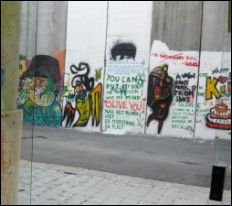By Hannah Brock
Greetings from Bethlehem! I write from a flat which stands about 100m away from the checkpoint through which everyone wishing to travel to Bethlehem from Jerusalem must pass.
This house will be my home for the next three months as I serve with the Ecumenical Accompaniment Programme in Palestine and Israel (EAPPI), providing protective presence to vulnerable communities and monitoring human rights abuses here in the West Bank.
Daunting welcome to Israel
My start here was been a busy one. It commenced with a difficulty entry into the country, as immigration officials held and questioned me for three hours on arrival at Ben Gurion Airport, along with two other internationals who were arriving to serve with EAPPI.
Thankfully we all were admitted, but it was a daunting welcome to Israel!
Training and handover
We began with ten days training and handover from the previous team based in Bethlehem, which was a valuable opportunity to meet with many Israeli groups working for peace, including Breaking the Silence (an organisation of ex-soldiers who collect testimonies of people who have served in the Israeli Defence Force (IDF) in the occupied Palestinian territories), and Machsom Watch (an all-Israeli group of women human rights activists who conduct daily observations at the checkpoints around the West Bank.)
Following our training, I travelled to Bethlehem with four colleagues (from Switzerland, Ecuador, Sweden and the USA) with whom I shall live and work over the coming months.
Our roles here
We shall be spending our time here visiting local communities, accompanying Israeli and Palestinians in non-violent actions such as demonstrations and vigils, and monitoring Checkpoint 300 – one of the largest checkpoints in the West Bank.
 One visit, to a family living just down the road from us, particularly moved me. The Anastas family are a Christian family who own gifts shop near Rachel’s Tomb (a site believed to be the burial place of the Rachel, the biblical matriarch), in Bethlehem.
One visit, to a family living just down the road from us, particularly moved me. The Anastas family are a Christian family who own gifts shop near Rachel’s Tomb (a site believed to be the burial place of the Rachel, the biblical matriarch), in Bethlehem.
The road on which their house and shop is based used to be a main road through the city, connecting Hebron and the Nativity Church, in the central Manger Square.
During the Second Intifada (an armed Palestinian uprising between 2001 and 2005) Israel started constructing a separation barrier as a security measure to regulate movement, which now stands less than 5m outside the front of the Anastas family home and business, and surrounds their block on three sides. The photo is of the view from their shop’s front door.
Barrier fully constructed through Bethlehem
The separation barrier was declared illegal by the International Court of Justice in 2004, as it does not stand on the Green Line – the line marks the 1949 Armistice line between Israel and Egypt, Jordan, Lebanon and Syria and has been used as a basis for negotiations as the boundary of a future state of Palestine – but cuts into Palestinian land in the West Bank. The barrier is not yet complete throughout the West Bank, but is fully constructed through Bethlehem.
The busy road along which the family ran these successful businesses is now blocked – it’s a dead street with a dead end. Tourists visiting Rachel’s tomb have no access to it, and this once successful business is failing.
However, the family’s previously prosperous position in the community has prevented them from being offered, and accepting, help.
Suffering under curfew
Like many others in Bethlehem, during the Second Intifada their road was often under curfew – once for 40 days – during which they were unable to leave their homes. UN aid supported other areas in the city with food and medical supplies, but their road was left out – they believe because their area was a previously thriving neighbourhood with wealthy families.
They were not perceived as vulnerable, but with their livelihood under threat during the curfews, and debts mounting up, they were suffering. Since going bankrupt they have struggled consistently, but the mother Claire explained that as they come from a successful family, it is particularly humiliating to ask for help: “There is a shame. You cannot tell anyone, even when you are starvingâ€, she said.
Held at gunpoint as soldiers gained access to their roof
Even after the curfews were lifted, they were still impacted by the Israeli response to the intifada. The location of the property is strategically important, so soldiers were camped out behind her house for a number of years. On one occasion, they needed to access the roof, so came knocking in the middle of the night.
Claire opened the door, and her husband and she were forced downstairs at gunpoint, whilst a soldier went upstairs to wake the children and force them from their rooms. When Claire herself accessed the roof some days afterwards, warning shots were fired close to her head, and she fell to the floor. They still need to apply for a permit if ever they wish to climb onto their own roof, which they used to do frequently, as there is a beautiful view of Bethlehem.
Soldiers trained lasers on children
Claire also described how on several occasions nearby soldiers trained their red laser guns on her children’s foreheads as they moved from the car to the house on their way home from school.
Claire says she finds the situation in Bethlehem particularly disturbing, since it is an “ancient city that has always embraced all peopleâ€. If you would like to hear more, take a look at the family shop’s website at www.anastas-bethlehem.com. There are also some more photos of the shop in Bethlehem.
This post was first published by Ventnor Blog. See: http://ventnorblog.com/2012/03/02/hannah-brocks-first-report-from-bethlehem-as-international-observer/#ixzz1nyPU1IDH and is published under Creative Commons License: Attribution Share Alike.